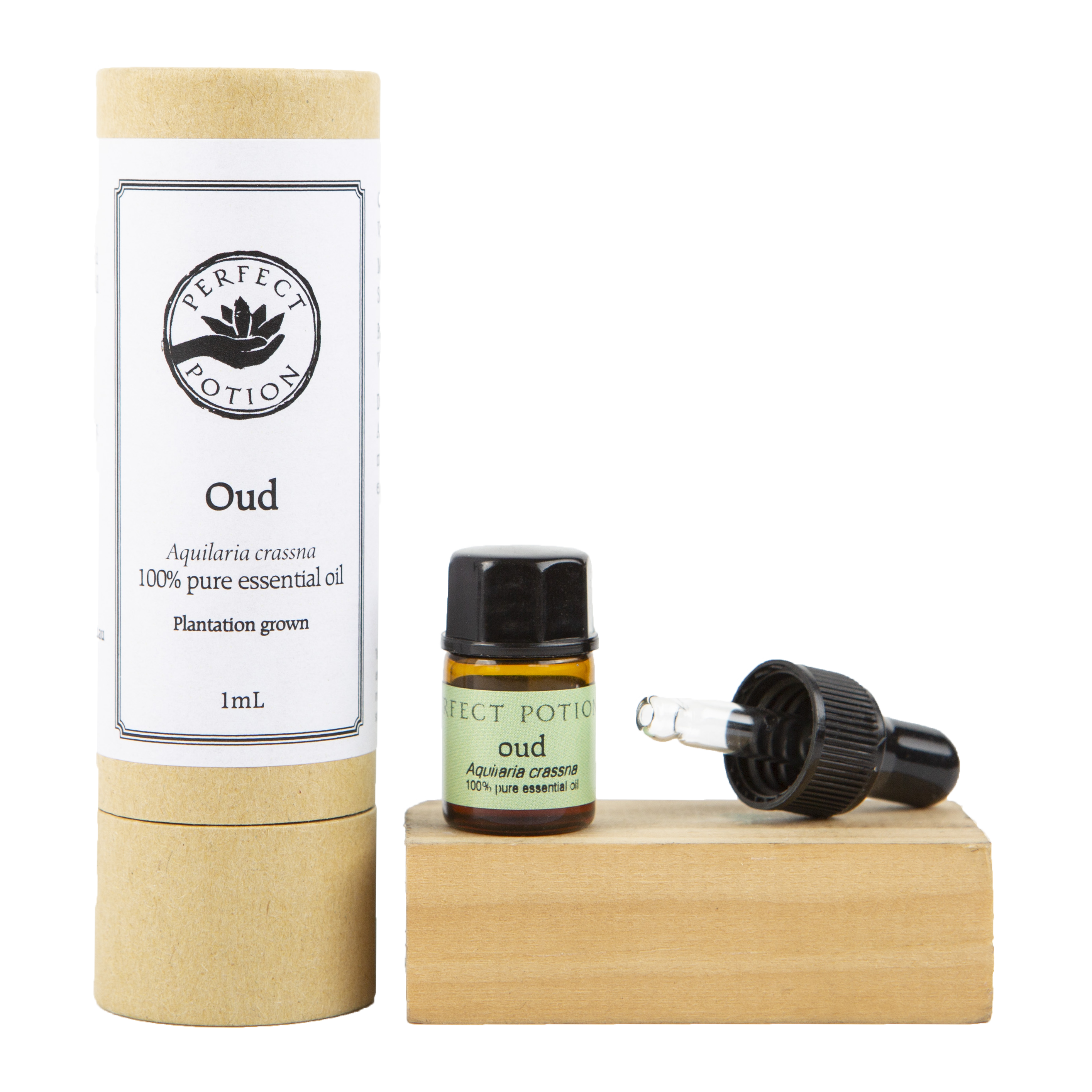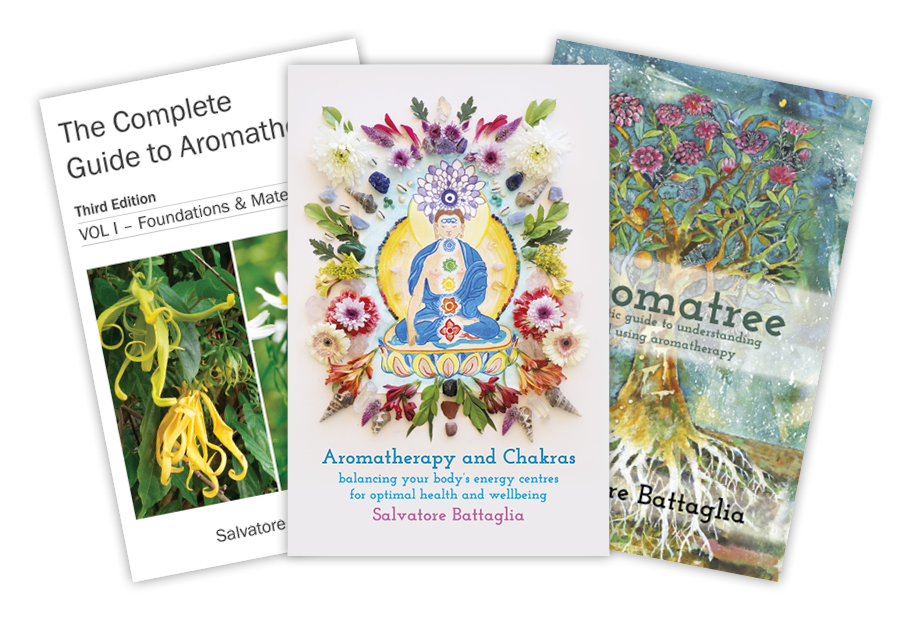The incense and perfume produced from oud otherwise known as agarwood have been highly valued for many centuries and used in many cultures for spiritual and perfumery purposes. It is highly revered in Hinduism, Christianity, Buddhism and Islam.1
Agarwood is the resin-infused fragrant wood (also known as aloewood, eaglewood, guharu, oud, chén xiāng and jinkoh) derived from the valuable heartwood of the Aquilaria spp.1,2
Botanical name
Aquilaria crassna
Family
Thymelaeaceae
Synonyms
Agarwood is known as Gaharu in Malaysia, Eaglewood and Krissana in Thailand, Oudh in the Middle East, Chen-xiang in China, Jin-koh in Japan and Agar in India.3
Botany and Origins
Agarwood is the resin impregnated heartwood of the Aquilari species. The resin is secreted by the trees as defence reaction and deposited around the wounds over years following the injury, where the volatile compounds eventually form agarwood.4
The species most commonly used for their essential oils are Aqularia malaccensis, A. crassna and A. sinensis.5
To date, there are a total of 21 Aquilaria species which have been documented and 13 of them are recognised as the agarwood-producing species.4
Akter et al. state agarwood can be produced from all members of the Aquilaria.6
The trees grow in natural forests at an altitude of a few hundred metres above sea level to about 1000 metres. It grows best around 500 metres in locations with average daily temperatures of 20 to 22 ˚C.6
The origin of the Aquilaria tree species is the wider Indo-Malayan region.3
The destructive exploitation of agarwood has had a devastating effect on wild population of all Aquilaria species. As a consequence, all of the Aquilaria species are now on the IUCN Red List as critically endangered species.7,8,9
Laos is the only country where harvesting of wild trees is still permitted.8
The trade data indicates that A. malaccensis followed by A. crassna and A. filaria are the agarwood species that have dominated the international trade for the past 10 years.2
The age of the tree is a major factor as infected trees produce a resin from the age of 15 years, with trees aged 50 years and more producing the best yields of agarwood.2
Formation of Agarwood
Naziz describes the unique scent of agarwood as the scent of stress, referring to the fact that the formation of the fragrant agarwood resin is the outcome of a complex interaction with a fungi and induced physical stress on the Aquilaria trees.2
As high demand for quality agarwood continues to grow an alternative, mass cultivation and large plantations of Aquilaria trees has become a sustainable source of agarwood to resolve the shortage of agarwood supply around the world. Since healthy Aquilaria trees do not form agarwood, the lack of naturally occurring agarwood has prompted the development of artificially agarwood-inducing methods.4
Efforts to artificially induce agarwood formation have been traced back to as early as AD 300 in China, where it was recorded that resin formation can happen within a year by injuring the trees. Apart from mechanical wounding approach, the use of chemical, insect and pathogen-inducing techniques is increasingly common in the agarwood industry. All these induction techniques attempt to mimic the natural processes for agarwood formation.4
Natural agarwood formation is often linked to the physical wounding or damage of Aquilaria trees caused by thunder strikes, animal grazing, pest and disease infestation. Natural agarwood formation in the natural environment is a long process which can take up to 10 years. Therefore, the development of an effective induction technology has received much attention in order to ensure the stability of agarwood yield from the domesticated Aquilaria trees.4
Understanding how the fungal interactions with the Aquilaria trees leads to the promotion of agarwood formation has led to the development of new induction methods that involve deliberate wounding coupled with the application of biological inoculum. Many pre-culture strains of fungi isolated from natural agarwood have been found to be effective biological agents to induce agarwood formation in healthy Aquilaria trees.4
The wood of the Aquilaria species is characterised as odourless, even-grained and of low density with a yellowish whitish colour. It is only under specific environmental conditions, and when the tree has been infected or wounded that the agarwood forms. Research suggests that the fungi cause an immune reaction associated with the production of the oleo-resin. The part of the wood infected grows with irregular patches of streaks which become increasingly dark and heavy.3
The specific character of the agarwood oil varies according to the region of origin, the botanical species, its age as well as the section of the tree from which the piece of agarwood comes from as well as the amount of time the wood has undergone the biological process.3
Extraction
The extraction of the oil is by distillation where the sun-dried chips with dark resin are soaked in water for 2-3 months and thereafter boiled to recover the oil.2
Characteristics
The aroma is considered one of the most complex olfactory accords known in perfumery today. It is often described as a ‘oriental-woody’ with a ‘soft fruity-floral’ note. The smoke from the incense made with high quality agarwood is described by perfumers as having a sweet-balsamic note with a hint of vanilla, musk and ambergris.3
What is most intriguing about this natural substance – which rightfully smells obnoxious to many – is that it is the most sought-after perfumery ingredient in the world and more expensive than gold.10
History
Ancient Egyptians were believed to be the first users of agarwood in death rituals more than 3,000 years ago. Presently agarwood oil is used in perfumery and cosmetic products and medicinal products throughout the world. It is considered without a doubt the most expensive and precious essential oil in the world.2
Traditional Sacred Uses
Agarwood is highly revered in Hinduism, Christianity, Buddhism, and Islam.1
Agarwood is considered one of the most sought after and expensive perfumery raw materials in the world. The incense and perfume produced from agarwood have been highly valued for many centuries and used in many cultures for spiritual and perfumery purposes. It is highly revered in Hinduism, Christianity, Buddhism and Islam.1
Agarwood is one of eight important aromatic ingredients in ashtagandha, a holy powder used in in deity worshipping and bathing. It was said that when Bhagavan Krishna was on earth the smell of ashtagandha was emanating from him. It is not surprising that other aromatic ingredients included sandalwood and spikenard.10
In the Holy Bible, agarwood was used with myrrh in the anointing of Christ following his crucifixion. The spiritual importance of agarwood in Buddhism was similarly demonstrated when it was used among other fragrant products in the cremation of Buddha.1
It was suggested that the five natural incense products that represented the speech of the five buddhas included sandalwood, agarwood, pine resin or juniper, camphor and vetiver root.1
Agarwood is cited three times in the Bible as a fragrant product for intimacy and seduction. In Islamic texts, agarwood was a conspicuous fragrance used in the ritual burning of incense, for spiritual purification, and as one of the rewards in Paradise. Agarwood mixed with camphor was the preferred scent of the Prophet Muhammad. The use of agarwood in many religious texts confirms its reputation as an important scent supporting spirituality.1
The Arabs are renowned for their love of oud. Since the beginning of Islam, oud has been a part of Arab daily life. There are ‘hadith’ or prophetic sayings in Islam that speak of oud and its benefits. Prophet Muhammad not only used oud himself, but recommended its use to his followers for its spiritually elevating aromas and health benefits.10
The introduction of Buddhism into China would have most likely promoted the interest in agarwood. The use of agarwood in China as an incense became prominent among the nobility. In 1225AD, a detailed account is provided that distinguishes different types of agarwood by considering their geographic location (e.g. Tonkin, Annam, Cambodia, Malay Peninsula, Sumatra) as well as the varying quality, appearance and fragrance.3
Use as Incense
Arabic incense is called bakhoor, which is agarwood chips burnt over charcoal in traditional incense burners, called mabkharah. Bakhoor is the quintessential symbol of celebration and is considered a sign of Arab hospitality. During social gatherings, the mabkharah is passed among the guests who, on receiving it recite prayers for the Prophet Muhammad.10
The first Japanese written record of agarwood was reported in AD 595, when a large piece of agarwood drifted ashore on the island of Awaji. The islanders noticed in wonder that it produced a string fragrance when used as firewood, and later presented an unburnt piece to Empress Suiko. Early aromatics burned in Japanese Buddhist ceremonies included jinkoh (the best agarwood), sandalwood, cloves, cinnamon and camphor.1
Traditional Medicine
Agarwood has been used for its medicinal properties in Ayurveda, Chinese, Tibetan and traditional East-Asian medicinal practices for thousands of years.11
In Ayurveda, agarwood was used for healing wounds, skin diseases, coughs and colds and long considered an aphrodisiac.10
Traditionally, the leaves, bark and root of Aquilaria agallocha have been used for their aphrodisiac, aromatic, astringent, bitter, cardiotonic, carminative and stimulant properties.11
In Malaysian traditional medicine, agarwood is mixed with coconut oil to make an ointment to treat body pain.12
Agarwood powder is used for the loss of appetite and digestive ailments. It improves blood circulation, reduces coughing and helps sooth bronchitis and asthma. Because of its cooling effect, agarwood is used to reduce fevers.11
Aquilaria crassna is the major source plant for agarwood in Vietnam. In Vietnam the wood of A. crassna is used in traditional medicine to assist digestion and as a sedative. It is prescribed in a Vietnamese medicine as a powder, aqueous preparation or tincture to treat gastralgia (pain in the stomach or epigastrium especially of a neuralgic type), nausea, vomiting and anxiety.
Contemporary uses
Agarwood is in high demand throughout the world as a raw material for incense, perfume and medicinal purposes. The Middle East and East Asia are the two major regions of consumption. The cost of the agarwood can be as high as $10,000 per kg and the value of agarwood essential oil can be as high as US$30,000 or more per kg.4
The oil is in high demand due to its use as an incense for religious ceremonies, in perfumes and traditional medicine preparations. In the Middle East it is considered a symbol of wealth and commonly used during wedding ceremonies.5
Agarwood oil is traded globally, however the main importers are the United Arab Emirates, Saudi Arabia, China and Japan.5
Chemical Composition
More than 150 compounds have been identified so far. Most of them are sesquiterpenoids and chromones.2
The chemical composition agarwood essential oil from Australian plantation-grown Aquilaria trees was reported as follows:
4-phenyl-2-butonone (0.3%), (-)selina-3,11-dien-9-one (2.01%), α-guaiene (2.41%), guaia-1(10),11-diene-15-ol (1.41%), agarospirol (1.1%), eremorphila-9,11(13) dien-12-ol (6.10%), epi-10-Y-eudesmol (3.42%), vetispirane-2(11)6(14)diene-7-ol (n/d), valance-1(10)8-diene-11-ol (6.44%), vetispirane type sesquiterpene (5.71%), 2,14-epoxy-vetispir-6-ene (1.87%), aragofuran (1.59%), guaiene type sesquiterpene (1.74%), guaia1(10), 11-diene-9-one (1.12%), selinene type sesquiterpene (1.85%), selina-3, 11-dien-9-ol (4.89%), 2-2-phenyl ethyl chromone derivative (1.27%).13
(4.47%), β-eudesmol (5.16%), 9,11-eremophiladien-8-one (2.28%), oxoagarospirol (2.38%).14
(-)-selina-3,11-dien,9-one and (+)-selina-3,11-dien,9-ol.5
Pharmacology and Clinical Studies
Pharmacological studies using agarwood oil have reported anti-cancer, analgesic, anti-inflammatory and antidepressant properties.2
It was reported that the potential mechanism might be through modulating central neurotransmitters such as dopamine.16
Properties
Oud oil is not mentioned in many aromatherapy books. However, the chemical composition and aroma of oud indicate that it has similar properties to spikenard or valerian essential oil. Based on the pharmacological studies, I would suggest that the properties of oud oil are anxiolytic, sedative and nervine.
Aromatherapy
The rather prohibitive price and the difficulty sourcing agarwood means that it is not commonly used in aromatherapy.
Aromatherapy uses
The anxiolytic and sedative properties of oud indicate that it would be beneficial for alleviating, anxiety, nervous tension and restlessness.
Energetics
The cooling nature of the oil suggests that the oil calms the Heart and soothes an agitated Shen. It would be ideal whenever one experiences nervous tension, anxiety and insomnia.
Subtle
I recommend using oud oil in subtle aromatherapy. Covington recommends using oud oil to amplify communication, effective listening skills and expression. She also recommends using the oil to purify emotional disharmony and to gain access to timeless wisdom and for the support in artistic expression.17
Unlike spikenard and vetiver which I find spirituality grounding, the scent of oud is spiritually elevating. I believe that the fragrance of oud carries with it a deep connection with all of humanity that has existed since it was first used. It reminds us that we are not alone on our journey and whenever we feel despondent, oud gives us the courage and strength to be devoted to our chosen path.
Blending
• Connecting with the divine blend – consider blending oud with frankincense, myrrh, spikenard or sandalwood.
• Promoting spiritual sensuality blend – consider blending oud with benzoin, cistus, patchouli, rose absolute or sandalwood.
• Connecting with nature blend - consider blending oud with galbanum, lavender, oakmoss absolute, patchouli or vetiver.
• Promoting courage and resilience blend – consider blending oud with atlas cedarwood, ginger, sandalwood or yakusugi.
• Grounding and nurturing blend - consider blending oud with atlas cedarwood, myrrh, patchouli, spikenard or vetiver.
Safety
References
2. Naziz PS et al. The scent of stress: evidence from the unique fragrance of agarwood Frontiers in Plant Science. 2019;10:840. doi:10.3389/fpls.2019.00840.
3. Jung D. The cultural biography – perfumery in Eastern Asia and in the Asian neighbourhood. Journal of the Royal Asiatic Society, 2013;23(1):103-125. doi:10.1017/s135618313000047
4. Tan CS et al. Agarwood induction: Current developments and future perspectives. Frontiers in Plant Science, 2019; 10: 122. doi: 10.3389/fpls.2019.00122
5. Ismail N et al. A review study of agarwood oil and its quality analysis. Jurnal Teknologi. 2014;68(1):37-42. eISSN 2180-3722
6. Akter S et al. Agarwood production – a multidisciplinary field to be explored in Bangladesh. International Journal of Pharmaceutical and Life Sciences. 2013; 2(1):22-32.
7. Harvey-Brown Y. Aquilaria crassna, Agarwood. The IUCN Red List of Threatened Species 2018: e.T32814A2824513. doi: 10.2305/IUCN. UK.2018-1.RLTS.T32814A2824513.en
8. Harvey-Brown Y. Aquilaria malaccensis, Agarwood. The IUCN Red List of Threatened Species 2018:T32056A2810130. doi: 10.2305/ IUCN.UK.2018-1.RLTS.T32056A2810130.en
9. Harvey-Brown Y. Aquilaria sinensis, Chinese Agarwood. The IUCN Red List of Threatened Species 2018:T32382A2817115. doi: 10.2305/IUCN.UK.2018-2.RLTS.T32382A2817115.en
10. Iyengar K. Exploring oud through two Eastern traditions. Downloaded on 17 July 2019 from https://www.perfumerflavorist.com/fragrance/applicaiton/finefrag/exploring-Oud--through-Two-Eastern-tradtions-465741663.html
11. Alam J et al. An insight of pharmacognostic study and phytopharmacology of Aquilaria agallocha. Journal of Applied Pharmaceutical Science. 2015; 5(8):173-181. Doi: 10.7324/JAPS.2015.50827.
12. Dahham SS et al. In vivo toxicity and antitumor activity of essential oils extract from agarwood (Aquilaria crassna). BMC Complementary and Alternative Medicine, 2016; 16:236.doi:10.1186/s12906-016-1210-1
13. Agarwood essential oil - Certificate of analysis. Westcorp Sandalwood, 2019.
14. Southern Cross University Plant. Certificate of Analysis – Agarwood (Aquilaria crassna ) Oil, Lismore, 2015.
15. Takemoto H et al. Sedative effects of vapor inhalation of agarwood and spikenard extract and identification of their active components. Journal of Natural Medicines. 2008;62(1):41-46. doi: 10.1007/s11418-007-0177-0.
16. Wang S et al. Chemical constituents and pharmacological activity of agarwood and Aquilaria plants. Molecules. 2018;23:324. doi:10.3390/molecules23020342
17. Covington C. Essential oils in spiritual practice. Healing Arts Press. Rochester, 2017.
18. Tisserand R, Young R. Essential oil safety. 2nd edn, Churchill Livingstone. Edinburgh, 2014.



